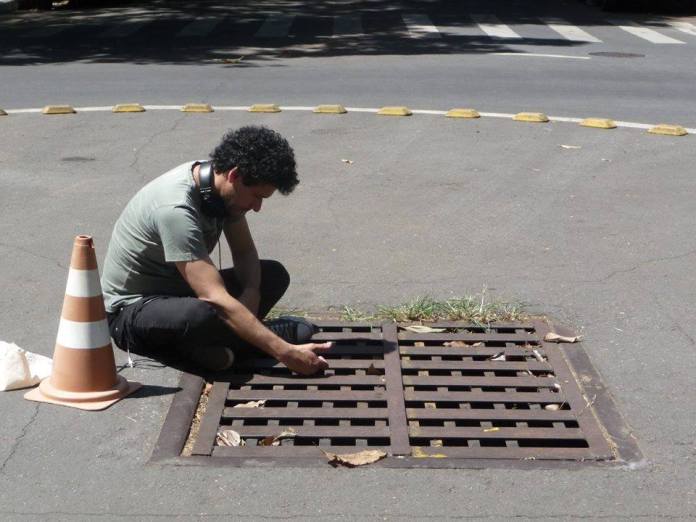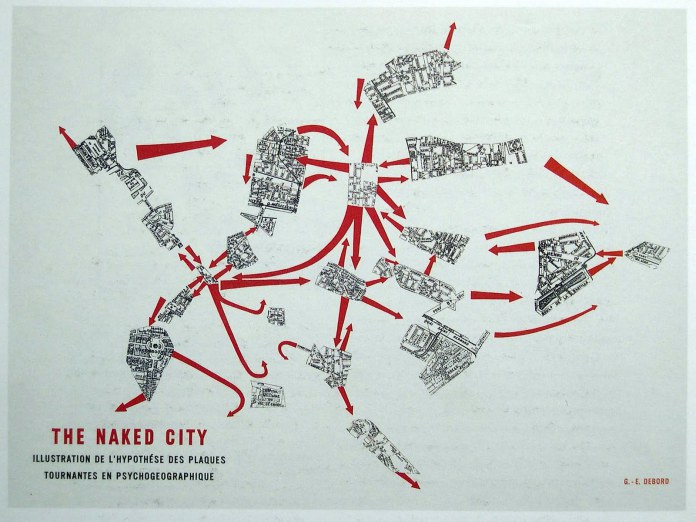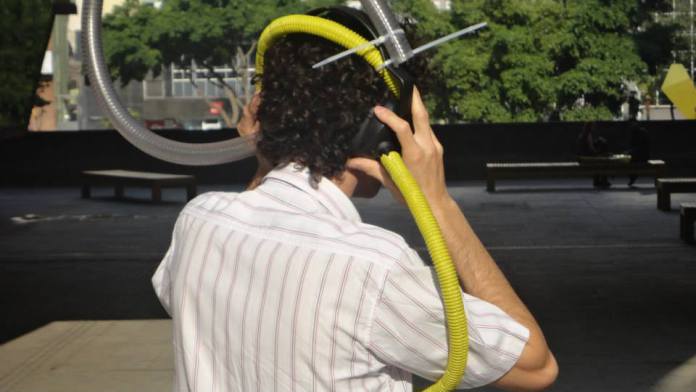‘Fishing for underground sounds’
The following interview with Marco Scarassatti – conducted by Thaís Aragão – was first published in portuguese on the Escuta Nova Onda blog run by the aforementioned researcher. It was done during the time when Marco Scarassatti just had released Rios Enclausurados on a local independent label called Seminal Records. This release was based on a series of field recordings that captured the sounds of Belo Horizonte covered and now underground rivers.
Thaís: How did you get to know about the city’s underground rivers? Why, and how did they caught your attention?
I discovered this in a ‘derive’ through the city. I had bought a bus ticket to Campinas in a Saturday afternoon, although the bus was scheduled to leave late that evening. I decided to go out and to let myself be taken by the sounds of the city. In one of the streets that I turned to, more precisely at ‘Rio Grande do Norte’, I heard a sound coming below street level. I got closer to a water drainage hole in the middle of the street – and I was suprised by what I saw. After that, I started paying attention and realised that the city had these ‘holes’ located in different streets.
Thaís: What are the rivers that we are listening to in Rios Enclausurados two tracks?
Rios Enclausurados consists of an edit of sound recordings made in Belo Horizonte’s several underground water streams. There (in the record) we have sounds from ‘Rio Grande do Norte’, ‘Avenida dos Andradas’, ‘Rua Sagarana’, and ‘Prudente de Moraes’ to mention a few.
Thaís: The recordings of these water streams were made in the tunnels, underneath the streets and with access only from the already mentioned ‘holes’. How did you manage to record these sounds?
When I started to record, I would position the recording device in the metal grid (covering the water drainage holes). I would normally do this alone, and in some streets this could be a dangerous endeavour. After that, in 2012, I started recording with Fernando Ancil, a friend mine who is also a visual artist. From that period onwards, we started lowering the recorder by using a nylon string noose on the device. It looked like we were fishing…fishing for sound. I have to point out that we would record at different distances, sometimes closer to the water, other times closer to street level.
Thaís: What was the equipment used – and how important is this topic for you?
I tried using different recorders, starting with the zoom H4N and then the H2N. Afterwards, I also used the Roland R-26. For this specific work, the choice of recorder is really important. The digital recorder, in its standard size, makes it easier to slip a device through the metal grids.
Thaís: Can you talk about the surroundings in the moment of recording?
Marco: The moment, the surroundings, the context of the recordings..these things were always variable. The interesting thing is to think that the city doesn’t listen to the river. Its sounding frequency is masked by the sounds of the city. The sound of the river almost ressembles a form of white noise, confined inside a concrete tube. But from that tube, one can listen to the city; and recording the external sounds to this tube confers to the listening process a certain difraction, like a ray light beaming through water.
Thaís: I asked the above question, because when I was listening, I started to imagine more and more the surroundings. For instance, in your first track there is the sound of water, but in some moment there is also a dog barking…and also something similar to human activity. In the second one, there are conversations and other distanced sounds that could be places, cars or even thunders. Nonetheless, the sound of the river is so strong and continuous, that for a few times, I got the sensation that I was listening to some radio station static; or that the sound itself of the river could possibly be of a plane, or a big thunderstorm.
Marco: The type of perception you describe is interesting. It delineates a scene of a certain idea of sonic abstractionism to it; maybe it is caused by the intensity and complexity of this type of ‘entubed sonority’ (due to the nature of where the recordings took place). That tube is also a resonator of the sounds that happen in the streets/roads, creating almost impercetible variations in the continuum you describe. Sometimes things that can be almost identifiable, such as a dog bark, a car horn or someone talking. Nonetheless, this is a fleeting moment. If we think about the river as a living being, I imagine these moments as spectres of a possible reality, as if ‘him’ – the river – was the prisoner in Plato’s cave. Imagine a cave with this small gap through which the sound comes in… it must be distressing to a river to live like this.

Fig.1 Marco Scarassatti ‘fishing’ for sounds in the streets of Belo Horizonte
Thaís: In this type of work, what do you generally expect from listeners?
Marco: For this work, I thought about giving it a name such as: ‘Eu grito para que me escute’ (roughly translated as ‘I scream in order for you to listen to me’). Anyways, I want to reproduce the sensation that was for me to discover a dungeon inside the city, a prison, a enclosed space where a forgotten prisoner lives (the river), supposedly invisible and silenced by urban planning. He cannot be visited. He is prived from the possibility of conversing with the city. But when one gets close to those metalic grids, suddenly you understand its potency and a sublime enchantment towards the idea that, with its strengh, it can break everything at any moment and decide its course once again.
Thaís: Have you heard about this colaborative mapping project (not sound specific) called Rios de São Paulo? It also approaches this invisibility of urban rivers.
Marco: No, I didn’t. Here in Belo Horizonte, we have a artist called Isabela Prado. For her exhibit Entre rios e ruas, she also recorded the rivers. I came upon this important project just recenly, but it’s been happening for a while now and it also focuses on recording and disseminating the sounds of these underground rivers.
Thaís: You also invite people to partake on ‘sonic derives’. How are these done and how do you plan this type of activities?
In the beginning, the idea of ‘derive’ was connected with my need to get closer to the city of Belo Horizonte. It was a way to get to know it, through the sounds that I became attracted to. Obviously, there is a big influence from the International Situationist theory of derive that Guy Debord published. I combined that with the soundwalking practices that had been developed by Hildegard Westerkamp, with the difference that I didn’t had any previously planned routes. Later on, I put these ideas to practice with a group that was part of a teacher training project I coordinate, on a governmental program called PIBID.
I chose a place that I already knew had a diversity of sounds, the Praça da Estação (Belo Horizonte). So, we make our rendez-vous there. Firstly, I suggested that each group should just start to listen to the sounds of that plaza. From there, they should let themselves go to the sounds they liked more. This was the stepping stone for those who would be interested afterwards to go out and investigate the city through the sounds they liked. During this first moment, we didn’t do any recording, in order to avoid feeling trapped by the simulation of listening that the microphone produces, or the idea that we had to produce something. I just wanted them to live this experience.

Fig.2 Guy Debord: a major inspiration for Marco Scarassatti
After they all returned, we gathered around to discuss the routes that each person had done and I proposed to them to retrace each path, while carrying a digital recorder – as if the listening process had left a trail of sonorities that we could re-visit. After this process, we gathered all the recorded material and did a sort of sonic postcard of the ‘Praça da Estação’. This wasn’t just a static report of these sounds, it was also a juxtaposition of movements and listening processes of the bodies involved in this action. Therefore, it became a complex postcard, with different listenings and different paths through the plaza.
During that time, I was also developing an old idea regarding the creation of ‘listening apparatuses’. These are relational objects that are mounted, in most cases, in security helmets. Each apparatus had a particular type of filtering different from one another. These are PVC pipes, horns or cones. These apparatuses were developed to be used in sonic derives, but also in musical concerts. They alter the listening process, not just due to the type of filter used, but also because it links our listening to a form of extensor that is leant to our ear – promoting also a form of listening through a physical medium. Due to these changes, I imagin imagine that our perception is engaged in adaptating to this apparatuses — making our ear bigger. In this way, and during the sonic derives, the helmet forces us to be fully mobilised towards listening.

Fig.3 An example of a listening apparatus used for ‘sonic derives’.
Thaís: Rios Enclausurados is contextualized by a larger project targeting the creation of a sonic cartography of Belo Horizonte. What other sounds of the city were selected, and how did the process of selection work?
Marcos: The idea of doing a sonic cartography of the city pressuposes the idea of listening as a tool for observation and research. We can use sound to think and learn about the word. A space is constituted by elements that interrelate and space out between each other, where we can also interact. If we understand sound as one of those elements, we can think that space (or a particular perspective on it) can happen through the different sounds that are part of it. Cartography is mapping those sounds, paths, detours, shortcuts; in other other words, to create another mimetic, reduced and simulated space where those sounds can be represented. At that time, I imagined doing a sonic cartography that would go from the underground sounds of a city to aereal sounds. I consider that the sonic elements that make up those spaces, are natural and cultural. Therefore they are, connected to environmental geography, to work, to technology, to speaking, to local idioms and language, to listened and produced music(s).
Thaís: You are author of the book Walter Smetak: O Alquimista dos Sons (Walter Smetak: The Sound Alchemist), part of the collection ‘Signos/Música’ (Ed. Perspectiva). Is it possible to link your interest in the work of the swiss-brazilian musician with your focus in building helmets as listening apparatuses?
Marcos: Yes, without a doubt! In one of his manuscripts, Smetak talks about the idea of having ‘quiet sounding objects’. Tridimensional forms from which we would be able to abstract a fourth dimension – sound. Besides this smetakian idea, I want to add a memory that I have from a Henry Corbin book in which he described a sufi prophet – that said that he had abdicated from music when he understood that it resided in silence. In the case of the helmets as an apparatus, the music is in the listening process… They create a topographic texture surface that outlines the ambient sounds.
Thaís: Your academic trajectory, from being an undergraduate student to PhD researcher, happened in Unicamp. But you went from composition to education, and also multimedia. What does this trajectory says about the questions that you developed in university?
Marcos: When I finished my graduation in musical composition, I was interested in transposing the limits of specific areas. I was interested in what lied beyond music, I was interested in what lied beyond visual arts. I was interested in the ‘in between’. That’s why I did postgraduate studies in multimedia, because I wanted to research the work of Smetak. The PhD in Education happened because I was interested in the work by the grupo Olho, that at that time was coordinated by Milton José de Almeida. In that group, one could research alchemy, sufism and other schools of thought that were replaced by the ones that became hegemonic and the basis for the contemporary world. Besides that, there was also a perspective that was less pedagogically orientated in the relationship between art and education. I think that every artist is, in a way, an educator and nothing of that has to do with efforts to pedagogize art in order for it to fit school curriculum.
Thaís: Now you’re a professor at theUFMG Faculty of Education. What contribution can the questions surrounding sound offer in order to face educational challenges?
Marcos: That is a great question, but one that doesn’t have an easy answer. I will try to do that by foregrounding questions that are part of my teaching practice. Firstly, I think that musical education, as a discipline, has distanced itself from music in order to legitimise itself as a discipline that produces its own range of knowledge. There is something endogenous in this process of consolidation. One emulates a specific knowledge, intrinsec to the field itself. Musical education discusses musical education and, most of times, music is an outsider, at least when it pertains to more contemporary forms of doing music or ways of organising sound. In a lot of cases, there is a reductionism in terms of thinking musical education as a series of infallible activities towards the process of becoming musical, being in a class, course, or path. The current paradigm is that a specific type of music imposes a normative idea of what is musical, and that music can improve the individuals’ ability to learn other skills.
Now, if we think that music is part of a sociocultural process connected to sounds, its organisation and interaction process, connected to a historical and geographical context. I think that even the name music should be thought as sounding arts, or sound art. Because this reflects in a broader, and more inclusive way, everything that is part of human sonic production. Having said that, I think that the action of listening should be valued as a way of being, inquiring and researching the world; and the relations that can be established and unfolded from it – material, simbolic, ephemeral and interactional – should be at the centre of the educational process.
//
Original interview by Thaís Aragão
Translation by Rui Chaves

